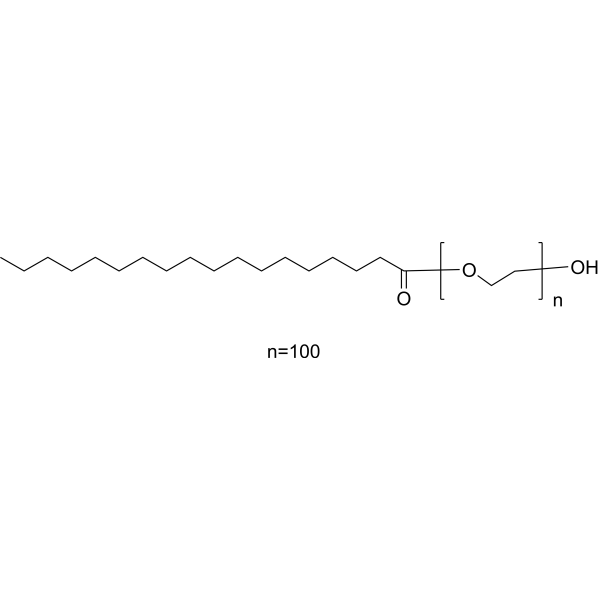
Polyoxyethylene stearate
CAS No. 9004-99-3
Polyoxyethylene stearate( POES )
Catalog No. M26792 CAS No. 9004-99-3
Polyoxyethylene stearate is an agent of non-ionic emulsifying.
Purity : >98% (HPLC)
 COA
COA
 Datasheet
Datasheet
 HNMR
HNMR
 HPLC
HPLC
 MSDS
MSDS
 Handing Instructions
Handing Instructions
| Size | Price / USD | Stock | Quantity |
| 200MG | 43 | In Stock |


|
| 500MG | Get Quote | In Stock |


|
| 1G | Get Quote | In Stock |


|
Biological Information
-
Product NamePolyoxyethylene stearate
-
NoteResearch use only, not for human use.
-
Brief DescriptionPolyoxyethylene stearate is an agent of non-ionic emulsifying.
-
DescriptionPolyoxyethylene stearate is an agent of non-ionic emulsifying.(In Vitro):Polyoxyethylene stearate inhibits P-gp mediated efflux in a concentration-dependent manner mainly by modulating substrate-stimulated P-gp ATPase activity. Polyoxyethylene stearate has been recommended as an additive to the radiolabelled 7H12 Middlebrook TB media and as such has been shown to enhance the growth of mycobacteria in the radiometric BACTEC rapid culture system. tuberculosis and polyoxyethylene (30) stearate and polyoxyethylene (JL) stearate for species of mycobacteria other than M. tuberculosis. Polyoxyethylene 40 stearate reduces vinblastine sulfate efllux. The cytotoxicity of vinblastine to K562/ADR cells is significantly enhanced when the cells are cotreated with 100 or 150 μg/mL polyoxyethylene 40 stearates. Polyoxyethylene (50) stearate produces the greatest enhancement in growth and reduction in the time taken to detect growth for M .(In Vivo):The average tumor volume and average tumor weight are significantly less in the polyoxyethylene 40 stearate+vinblastine group. The inhibition rate for tumor growth is increased from 0.06 (vinblastine group) to 0.84 (vinblastine+polyoxyethylene 40 stearate group). Polyoxyethylene stearate is potentially useful as a pharmaceutical ingredient to improve the oral bioavailability of coadministered P-gp substrates and substrates for certain CYP isoforms .
-
In VitroPolyoxyethylene stearate has been recommended as an additive to the radiolabelled 7H12 Middlebrook TB media and as such has been shown to enhance growth of mycobacteria in the radiometric BACTEC rapid culture system. Polyoxyethylene (50) stearate produces the greatest enhancement in growth and reduction in the time taken to detect growth for M. tuberculosis and polyoxyethylene (30) stearate and polyoxyethylene (JL) stearate for species of mycobacteria other than M. tuberculosis. Polyoxyethylene stearate inhibits P-gp mediated efflux in a concentration dependent manner mainly by modulating substrate-stimulated P-gp ATPase activity. Polyoxyethylene 40 stearate reduces vinblastine sulfate efllux. The cytotoxicity of vinblastine to K562/ADR cells is significantly enhanced when the cells are cotreated with 100 or 150 μg/mL polyoxyethylene 40 stearate.
-
In VivoPolyoxyethylene stearate is potentially useful as a pharmaceutical ingredient to improve the oral bioavailability of coadministered P-gp substrates and substrates for certain CYP isoforms. The average tumor volume and average tumor weight are significantly less in the polyoxyethylene 40 stearate+vinblastine group. The inhibition rate for tumor growth is increased from 0.06 (vinblastine group) to 0.84 (vinblastine+polyoxyethylene 40 stearate group).
-
SynonymsPOES
-
PathwayGPCR/G Protein
-
TargetAntibacterial
-
RecptorRac1
-
Research Area——
-
Indication——
Chemical Information
-
CAS Number9004-99-3
-
Formula Weight——
-
Molecular FormulaC20H40O3
-
Purity>98% (HPLC)
-
SolubilityIn Vitro:?DMSO : 100 mg/mL
-
SMILESO=C(OCCO)CCCCCCCCCCCCCCCCC.[n].[n].[=].[10]
-
Chemical Name——
Shipping & Storage Information
-
Storage(-20℃)
-
ShippingWith Ice Pack
-
Stability≥ 2 years
Reference
1.Gonzalez N, et al. Pharmacological inhibition of Rac1-PAK1 axis restores tamoxifen sensitivity in human resistant breast cancer cells. Cell Signal. 2017 Jan;30:154-161.
molnova catalog



related products
-
Vancomycin hydrochlo...
An antibiotic used to treat a number of bacterial infections that acts by inhibiting proper cell wall synthesis.
-
Xanthorrhizol
Xanthorrhizol is a natural product isolated from Curcuma xanthorrhiza Roxb. Xanthorrhizol is a potential antibacterial agent.
-
Lalistat 1
Lalistat 1 is an inhibitor of lysosomal acid lipase (LAL, IC50 = 68 nM) and IgA1 protease for H. influenzae.



 Cart
Cart
 sales@molnova.com
sales@molnova.com


